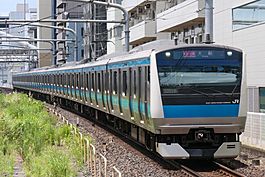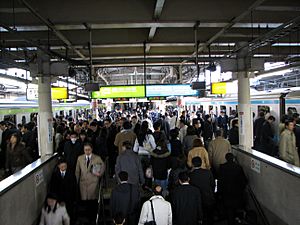Keihin–Tōhoku Line facts for kids
Quick facts for kids Keihin-Tōhoku Line |
|
|---|---|
| JK | |

JR East E233 series EMU in Saitama-Shintoshin Station
|
|
| Overview | |
| Native name | 京浜東北線 |
| Locale | Tokyo, Saitama, Kanagawa prefectures |
| Termini | Ōmiya Yokohama |
| Stations | 36 |
| Service | |
| Type | Heavy rail |
| Operator(s) | |
| Depot(s) | Saitama |
| Rolling stock | E233 series |
| Daily ridership | 2,974,504 (daily 2015) |
| History | |
| Opened | December 20, 1914 |
| Technical | |
| Line length | 59.1 km (36.7 mi) |
| Number of tracks | Double-track |
| Track gauge | 1,067 mm (3 ft 6 in) |
| Electrification | 1,500 V DC (overhead catenary) |
| Operating speed | 90 km/h (56 mph) |
The Keihin–Tōhoku Line (Japanese: 京浜東北線, Hepburn: Keihin-tōhoku-sen) is a busy railway line in Japan. It connects big cities like Saitama, Kawaguchi, Tokyo, Kawasaki, and Yokohama. This line is part of the East Japan Railway Company (JR East) network.
The name "Keihin-Tōhoku" comes from parts of the cities it connects. "Kei" (京) is from Tokyo (Japanese: 東京). "Hin" (浜) is from Yokohama (Japanese: 横浜). "Tōhoku" (Japanese: 東北本線) refers to the Tōhoku Main Line, which this line runs alongside for part of its journey.
The Keihin-Tōhoku Line runs next to the Tōkaidō Main Line between Yokohama and Tokyo. It also runs parallel to the Utsunomiya Line (which is part of the Tōhoku Main Line). However, between Ueno and Akabane stations, the two lines are separate.
Most trains on the Keihin–Tōhoku Line continue their journey onto the Negishi Line. This "through service" means trains go all the way from Ōmiya to Ōfuna without passengers needing to change trains. Because of this, the whole route is often called the Keihin-Tōhoku–Negishi Line (Japanese: 京浜東北・根岸線). You can easily spot these trains by their light blue stripe. This light blue is also the line's color on train maps.
Contents
How Trains Run on the Keihin-Tōhoku Line
Trains on this line run very often. During busy times, like morning and evening rush hours, a train comes every 2 to 3 minutes! During the middle of the day, trains run every 5 to 6 minutes.
Most trains are called "Local" (各駅停車 (Kakueki-Teisha)). This means they stop at every single station along the route.
Rapid Services: Faster Journeys
During the daytime (from 10:30 AM to 3:30 PM), all trains are "Rapid" (快速 (kaisoku)) services. These rapid trains skip some stations in central Tokyo. This is because the Keihin-Tōhoku Line runs right next to the Yamanote Line in this area. Skipping stops helps people get to their destinations faster.
Stations on the Keihin-Tōhoku Line
Local trains stop at all stations. Rapid trains only stop at stations marked with a "●" or "■". Stations marked with "■" are special because you can easily switch to the Yamanote Line from the same platform. Stations marked with "▲" are served by rapid trains only on weekends and national holidays.
| Line name | No. | Station | Japanese | Distance (km) | Rapid | Transfers | Location | ||||
|---|---|---|---|---|---|---|---|---|---|---|---|
| Between stations |
Total | ||||||||||
| from Ōmiya |
from Tokyo |
||||||||||
| Tōhoku Main Line |
OMYJK47
|
Ōmiya | 大宮 | - | 0.0 | 30.3 | ● |
|
Ōmiya-ku, Saitama | Saitama | |
| JK46 | Saitama-Shintoshin | さいたま新都心 | 1.6 | 1.6 | 28.7 | ● |
|
||||
| JK45 | Yono | 与野 | 1.1 | 2.7 | 27.6 | ● | Urawa-ku, Saitama | ||||
| JK44 | Kita-Urawa | 北浦和 | 1.6 | 4.3 | 26.0 | ● | |||||
|
URWJK43
|
Urawa | 浦和 | 1.8 | 6.1 | 24.2 | ● |
|
||||
| JK42 | Minami-Urawa | 南浦和 | 1.7 | 7.8 | 22.5 | ● | JM Musashino Line | Minami-ku, Saitama | |||
| JK41 | Warabi | 蕨 | 2.8 | 10.6 | 19.7 | ● | Warabi | ||||
| JK40 | Nishi-Kawaguchi | 西川口 | 1.9 | 12.5 | 17.8 | ● | Kawaguchi | ||||
| JK39 | Kawaguchi | 川口 | 2.0 | 14.5 | 15.8 | ● | |||||
|
ABNJK38
|
Akabane | 赤羽 | 2.6 | 17.1 | 13.2 | ● |
|
Kita | Tokyo | ||
| JK37 | Higashi-Jūjō | 東十条 | 1.8 | 18.9 | 11.4 | ● | |||||
| JK36 | Ōji | 王子 | 1.5 | 20.4 | 9.9 | ● |
|
||||
| JK35 | Kami-Nakazato | 上中里 | 1.1 | 21.5 | 8.8 | ● | |||||
| JK34 | Tabata | 田端 | 1.7 | 23.2 | 7.1 | ■ | JY Yamanote Line | ||||
| JK33 | Nishi-Nippori | 西日暮里 | 0.8 | 24.0 | 6.3 | | |
|
Arakawa | |||
|
NPRJK32
|
Nippori | 日暮里 | 0.5 | 24.5 | 5.8 | | |
|
||||
| JK31 | Uguisudani | 鶯谷 | 1.1 | 25.6 | 4.7 | | | JY Yamanote Line | Taitō | |||
|
UENJK30
|
Ueno | 上野 | 1.1 | 26.7 | 3.6 | ■ |
|
||||
| JK29 | Okachimachi | 御徒町 | 0.6 | 27.3 | 3.0 | ▲ |
|
||||
|
AKBJK28
|
Akihabara | 秋葉原 | 1.0 | 28.3 | 2.0 | ■ |
|
Chiyoda | |||
|
KNDJK27
|
Kanda | 神田 | 0.7 | 29.0 | 1.3 | ■ |
|
||||
|
TYOJK26
|
Tokyo | 東京 | 1.3 | 30.3 | 0.0 | ■ |
|
||||
| Tōkaidō Main Line | |||||||||||
| JK25 | Yūrakuchō | 有楽町 | 0.8 | 31.1 | 0.8 | | |
|
||||
|
SMBJK24
|
Shimbashi | 新橋 | 1.1 | 32.2 | 1.9 | | |
|
Minato | |||
|
HMCJK23
|
Hamamatsuchō | 浜松町 | 1.2 | 33.4 | 3.1 | ■ |
|
||||
| JK22 | Tamachi | 田町 | 1.5 | 34.9 | 4.6 | ■ |
|
||||
|
TGWJK21
|
Takanawa Gateway | 高輪ゲートウェイ | 1.3 | 36.2 | 5.9 | ● |
|
||||
|
SGWJK20
|
Shinagawa | 品川 | 0.9 | 37.1 | 6.8 | ● |
|
||||
| JK19 | Ōimachi | 大井町 | 2.4 | 39.5 | 9.2 | ● |
|
Shinagawa | |||
| JK18 | Ōmori | 大森 | 2.2 | 41.7 | 11.4 | ● | Ōta | ||||
| JK17 | Kamata | 蒲田 | 3.0 | 44.7 | 14.4 | ● |
|
||||
|
KWSJK16
|
Kawasaki | 川崎 | 3.8 | 48.5 | 18.2 | ● |
|
Kawasaki-ku, Kawasaki | Kanagawa | ||
| JK15 | Tsurumi | 鶴見 | 3.5 | 52.0 | 21.7 | ● |
|
Tsurumi-ku, Yokohama | |||
| JK14 | Shin-Koyasu | 新子安 | 3.1 | 55.1 | 24.8 | ● | KK Keikyu Main Line (Keikyū Shinkoyasu) | Kanagawa-ku, Yokohama | |||
| JK13 | Higashi-Kanagawa | 東神奈川 | 2.2 | 57.3 | 27.0 | ● |
|
||||
|
YHMJK12
|
Yokohama | 橫浜 | 1.8 | 59.1 | 28.8 | ● | Nishi-ku, Yokohama | ||||
| Through service via the JK Negishi Line to Sakuragichō, Isogo, and Ōfuna | |||||||||||
Trains Used on the Keihin-Tōhoku Line
Since January 2010, all trains on the Keihin-Tōhoku Line are E233-1000 series trains. These are 10-car electric trains, meaning they have 10 connected cars. They started being used in December 2007 and fully replaced the older 209 series trains by January 2010.
All Keihin-Tōhoku Line trains are kept and maintained at the Urawa Depot. Some Yokohama Line trains, which are E233-6000 series (8-car trains), also run on the Keihin-Tōhoku Line. They do this for "through services" between Higashi-Kanagawa and Ofuna stations.
Current Trains on the Keihin-Tōhoku Line
- E233-1000 series 10-car electric trains (these have a sky blue stripe).
Trains from the Yokohama Line
- E233-6000 series 8-car electric trains (these have a light/dark green stripe). They started running in February 2014.
Older Trains Used in the Past
Over the years, many different types of trains have run on the Keihin-Tōhoku Line. Here are some of them:
- 72 series 8-car trains (brown color) - used until October 1970.
- 101 series 10-car trains (sky blue color) - used from December 1970 to March 1978.
- 103 series 10-car trains (sky blue color) - used from October 1965 to March 1998.
- 205 series 10-car trains (sky blue stripe) - used from October 1989 to February 1996.
- 205 series 8-car trains (light/dark green stripe) - used on Yokohama Line services until August 2014.
- 209-900 series 10-car trains (sky blue stripe) - used from May 1992 to August 2007.
- 209-0 series 10-car trains (sky blue stripe) - used from March 1993 to January 2010.
- 209-500 series 10-car trains (sky blue stripe) - used from January 2001 to 2009.
Timeline of Keihin-Tōhoku Line Trains
History of the Keihin-Tōhoku Line
The Keihin-Tōhoku Line first opened on December 20, 1914. It was an electric passenger line. It connected Shinagawa Station in Tokyo with Takashimacho Station in Yokohama. Takashimacho Station was later renamed Yokohama Station in August 1915. The original Yokohama Station then became Sakuragicho Station.
The line was first called the Tokaido Electric Line (Japanese: 東海道電車線). Later, its name changed to the Keihin Line (Japanese: 京浜線). On December 30, 1915, the train services were extended south to the new Sakuragicho Station.
The Keihin Line was extended north in stages. In February 1928, it reached Akabane Station. By September 1932, it was extended all the way to Ōmiya Station.
Changes to Train Cars Over Time
When the Keihin Line first started, it had two types of cars: "third-class" and "second-class." These were similar to today's regular cars and special "Green Cars." Second-class service stopped in 1938. This was to make room for special military cars during World War II. After the war, these military seats were used for women and children. In 1973, they became regular seats again because trains were very crowded.
In November 1956, the Keihin-Tōhoku Line tracks were physically separated from the Yamanote Line tracks between Tamachi and Tabata. This change helped trains run more often. "Through service" with the Negishi Line began on May 19, 1964. Longer trains with 10 cars (103 series) started running on April 1, 1966.
"Rapid" services, which skip some stops, were added in 1988. This helped reduce crowding along the busy Yamanote Line area. From March 14, 2015, all rapid trains began stopping at Kanda Station. Also, rapid trains started stopping at Okachimachi Station only on weekends and national holidays.
On August 20, 2016, station numbers were added to the line. Stations were given numbers from JK12 to JK47. The numbers increase as you go north towards Omiya.
A brand new station, the Takanawa Gateway Station, opened on March 14, 2020. It was ready for the 2020 Summer Olympics in Tokyo. This station is located on both the Yamanote Line and Keihin-Tōhoku Line. It sits between Shinagawa and Tamachi stations. The area around Takanawa Gateway is being redeveloped with new buildings and businesses.
Train Accident in 2014
Early in the morning on February 23, 2014, an empty train hit a maintenance vehicle near Kawasaki Station. The first two cars of the 10-car train went off the tracks, and the first car fell onto its side. There were no passengers on the train. The driver and conductor had only minor injuries.
Images for kids
-
Morning peak on the Keihin-Tohoku and Yamanote Lines at Ueno Station
See also
 In Spanish: Línea Keihin-Tōhoku para niños
In Spanish: Línea Keihin-Tōhoku para niños
- List of railway lines in Japan













